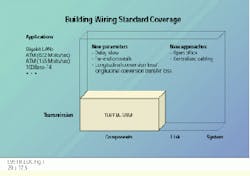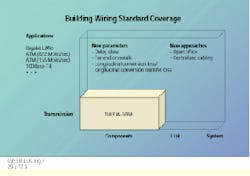Bicsi launches Standards Update at annual workshop
Arlyn S. Powell, Jr.
A well-attended feature of this year`s Bicsi Summer Workshop was a new Standards Update session, in which several technical experts fresh from the quarterly meeting of the Telecommunications Industry Association (TIA, Arlington, VA) brought workshop attendees up to speed on the latest changes to TIA building wiring standards.
Moderated by Donna Ballast, registered communications distribution designer (Rcdd), and standards representative for Bicsi (Tampa, FL), the Standards Update session featured presentations by Paul Kish, senior product manager for the Network Systems Division of Nordx/Cdt (St. Laurent, QC, Canada); Bob Jensen, Rcdd, senior design consultant for dbi (Austin, TX); and Trevor Olsen, Rcdd, technical product manager for the Networks Systems Division of Panduit Corp. (Tinley Park, IL). Kish covered recent developments around the core building wiring standard, TIA/EIA-568A. Jensen discussed conduit fill and pulling tension, and Olsen discussed pathway separation.
Kish pointed out that the current building wiring standard, TIA/EIA-568A, covers only a portion of the areas affecting cabling system designers and installers. "The standard is a process," he said. "It`s ongoing, not fixed."
Currently, TIA/EIA-568A covers transmission systems at the component level. Among the areas not addressed by the basic standard are applications (such as Asynchronous Transfer Mode and Gigabit LAN), newly recognized cabling parameters (such as delay skew and far-end crosstalk), new cabling approaches (such as centralized fiber-optic cabling and open-office cabling), and link- and system-level concerns.
"People make assumptions about cable," Kish said. "One of them is that if you specify standards-compliant components and connect them reasonably, the result will be a usable link. This is not necessarily true. There can be interactions between components; there are design variables such as impedance matching; and there is installation craftsmanship. All three can affect predictions made using a link model."
Kish indicated that some of these issues concerning unshielded twisted-pair (UTP) cabling are currently under review by the TIA. Propagation delay and delay skew, for example, can result when twisted pairs within a cable are jacketed with different materials; the TIA has issued an advisory that this characteristic of some Category 5 UTP cables is under investigation (see "TIA issues warning about Category 5 cable," June 1996, page 67). A telecommunications systems bulletin (TSB) has been drafted to address the problem and is now out for comments.
The TIA/EIA-568A committee is also reviewing the problem of resonance in short cable links. In this situation, horizontal cable links substantially shorter than the TIA upper limit of 90 meters may fail the Category 5 crosstalk test because resonance from far-end crosstalk pushes this parameter over the limit.
Another area of concern has been the performance of patch cords in horizontal links. "Stranded cables can change in performance by up to 20% over time," said Kish. This loss--mostly due to humidity--was brought to the attention of the committee by Belden Wire & Cable Co. (Richmond, IN) and is probably due to air getting between the cable strands (see "Belden introduces high-performance patch cables," page 105). "It doesn`t affect solid cables," Kish added.
The TIA/EIA-568A committee is also planning a study on specifying and testing extended-performance Category 5 UTP cable (see "Jury still out on extended-performance Category 5 cable," July 1996, page 18). "An enhanced twisted-pair specification is a year or two down the road," Kish said. "It needs to address components as well as cable."
Kish also mentioned that two TSBs had recently been published and would be incorporated in future versions of the TIA/EIA-568A standard. TSB-72 proposes centralized optical-fiber cabling guidelines that can eliminate much of the hardware needed in the telecommunications closet for horizontal copper-cable runs because of the 90-meter length limitation placed on Category 5 UTP cabling (see "TIA issues guidelines for centralized optical-fiber cabling," May 1996, page 64). TSB-75 is a new cabling guideline that addresses the issues surrounding multimedia communications in an open-office environment.
Bob Jensen pointed out that the question of how full a conduit could be was currently addressed in the TIA/EIA-569 standard, which uses the same specification as the National Electrical Code (NEC). However, he states that the National Fire Protection Association (Nfpa, Quincy, MA), the official keeper of the NEC, has said that Table 9 of the NEC, which specifies conduit fill limits, does not apply to telecommunications cables (see "TIA studies conduit-fill requirement," August 1996, page 64).
"This is a personal opinion, though," adds Jensen. "The TIA has written to the Nfpa for a formal interpretation." This interpretation may not be received for two years, so in the interim, the Bicsi standards committee is setting up a task group to study the issue.
Olsen explained that his TIA committee, which was concerned with pathway separation between telecommunications and electrical cables, had done some testing to see how much electromagnetic interference (EMI) resulted when high- and low-voltage cables were run in close proximity. The results will be used in the revision of TIA/EIA-569, the TIA`s pathways and spaces standard, which is currently under way.
The test setup included the worst-case electrical disturber the committee could find in an office environment--an electric pencil sharpener. A standardized testing method was then devised, based on an equivalent to this worst-case disturber. This equivalent noise threshold was 500 volts, but additional network testing showed that it took a disturbance of five times this value--2500V--to create an error in a token ring network.
The committee backed up its testing with a questionnaire to the industry, which indicated that pathway separation was not a major concern for most people. The committee`s final proposal, which is being balloted this month, is that pathway separation be governed for safety by the NEC. (In other words, physical separation to prevent EMI is no longer considered a significant technical issue.)
The committee`s proposal also suggests that separation still be maximized where possible; power conductors be maintained close together to minimize interference; surge protectors be used in branch circuits; and fully enclosed and grounded metallic raceways, which have been found to be least susceptible to EMI, be used to house telecommunications cables where possible.
In a graphic demonstration of the problem created by the 25-pound pulling-tension limit set for Category 5 UTP cable, Jensen and Ballast set up a test stand with a cable attached to a tensionmeter. Experienced cablers almost universally pulled this cable at more than 25 pounds tension when they were asked to pull the cable as they typically would during an installation. q
The issues covered by the TIA/EIA-568A building wiring standard represent only a fraction of those affecting cable system designers and installers. Other areas not addressed by the standard include applications, newly recognized cable parameters, new cabling approaches and link- and system-level issues.

